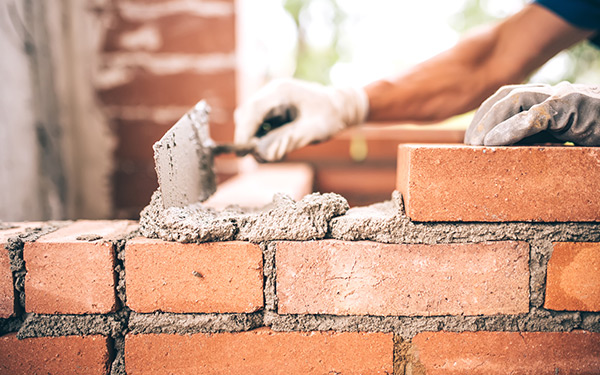Opening the Keys of Lasting Stonework Building And Construction Practices for Eco-Friendly Structures
Amongst the myriad techniques to eco-friendly structure, lasting masonry building stands out as a reliable and resilient approach that holds a wealth of untapped capacity. From the selection of materials to innovative building and construction techniques, the secrets to attaining sustainability within masonry construction are complex and intriguing.
Benefits of Lasting Stonework Building
Embracing lasting masonry construction practices not just lowers ecological effect but also supplies long-lasting financial benefits to builders and areas. By making use of materials like recycled bricks, obstructs, and rocks, home builders can substantially reduce the carbon footprint of their tasks while advertising resource performance. Furthermore, lasting stonework building techniques, such as correct insulation and thermal mass residential or commercial properties, can enhance power effectiveness within buildings, leading to lowered operational prices gradually.
Moreover, the resilience and strength of masonry frameworks add to long-term economic benefits. Structures constructed making use of sustainable stonework techniques often call for less maintenance and repair, equating to set you back savings for building contractors and homeowner. The durability of stonework materials likewise makes certain that structures stay secure and safe, reducing the demand for frequent restorations or substitutes.
Eco-Friendly Masonry Products
Utilizing green masonry materials is a crucial step in the direction of improving the sustainability of building and construction techniques and lessening ecological impact while making best use of long-lasting financial advantages. Lasting stonework materials are sourced, produced, and utilized in a way that minimizes overall environmental effect. Products such as recycled blocks, redeemed rock, and lasting cinder block are coming to be increasingly prominent options for eco-conscious building contractors. Recycled blocks, as an example, not just draw away waste from land fills yet likewise require much less power to generate contrasted to brand-new blocks. Redeemed rock offers a distinct aesthetic appeal while decreasing the need for new quarrying. Lasting concrete obstructs integrate recycled aggregates and may feature better insulation properties, adding to power effectiveness in structures.
Furthermore, all-natural products like adobe, rammed planet, and straw bales give superb thermal mass residential properties, decreasing the demand for heating and cooling power. These products are frequently locally offered, advertising regional economic situations and minimizing transportation-related carbon discharges. By picking green masonry products, building and construction jobs can significantly minimize their ecological footprint and add to the creation of healthier, a lot more sustainable constructed atmospheres.
Energy-Efficient Stonework Strategies
Energy performance plays an important duty in enhancing the sustainability of masonry building and construction practices. By executing energy-efficient stonework techniques, home builders can dramatically reduce the overall power intake of a structure, leading to lower operational prices and a smaller sized environmental footprint. One essential energy-efficient masonry method is the usage of thermal mass, which entails incorporating dense materials like concrete or brick into the structure's framework to soak up and save warmth. This aids control indoor temperatures, minimizing the demand for mechanical home heating and cooling systems.

Advancements in Sustainable Stonework
Recent improvements in sustainable concrete sidewalk cost masonry techniques have actually caused innovative strategies that are reshaping the building sector. One such advancement is the growth of self-healing concrete, which utilizes microorganisms embedded within the concrete to heal fractures autonomously. This breakthrough not only lowers maintenance expenses yet also improves the resilience of masonry frameworks, contributing to their sustainability.
One more significant innovation is using recycled accumulations in stonework building - masonry contractor. By including materials such as crushed ceramic waste or recycled glass into concrete blends, builders can decrease the ecological influence of construction projects while preserving structural stability. This method not just draws away waste from land fills however likewise saves natural deposits, making it a vital development in sustainable masonry building
In addition, the integration of digital design tools, such as Building Information Modeling (BIM), is revolutionizing the way masonry structures are planned and find this constructed. BIM permits even more specific computations, lowered material wastefulness, and boosted power efficiency, ultimately leading to even more lasting structure methods. These technologies jointly symbolize an appealing future for lasting masonry construction in the era of eco-friendly structures.
Future Trends in Stonework Sustainability
With the ingenious strides made in sustainable stonework techniques, the future fads in masonry sustainability are poised to more change the building market. One of the vital fads shaping the future of masonry sustainability is the increased assimilation of innovation. Developments such as Building Details Modeling (BIM) and online reality simulations are being made use of to enhance masonry building processes, leading to lowered product waste and improved energy performance in structures.
Additionally, the growth of unique sustainable products is established to play a considerable role in boosting the eco-friendliness of stonework construction. masonry contractor. Innovations like self-healing concrete, recycled accumulations, and bio-based binders are acquiring traction for their ability to lessen environmental influence while preserving architectural stability

Verdict
To conclude, lasting stonework building and construction practices offer various advantages for eco-friendly buildings. By utilizing environment-friendly products and energy-efficient strategies, stonework can add to a more sustainable developed atmosphere. Technologies in sustainable masonry are continuously being created to further enhance the ecological efficiency of structures. Looking in the direction this post of the future, the fad of stonework sustainability is expected to grow, resulting in more eco-friendly and energy-efficient construction techniques in the years ahead.